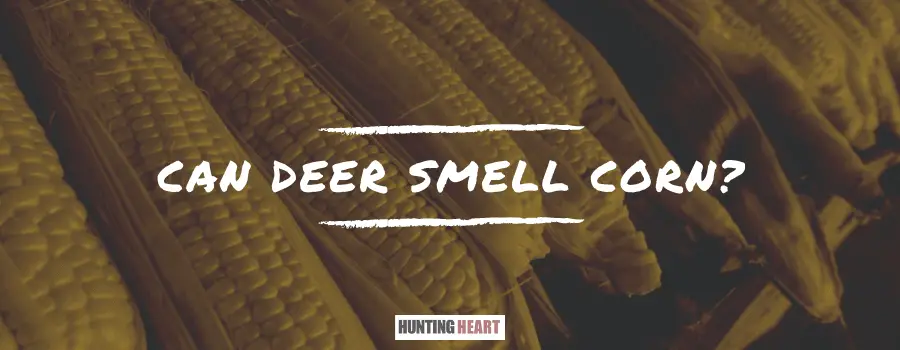As an Amazon Associate I earn from qualifying purchases.
Our Associate portal can be found here
You must have seen seasoned hunters strategically placing corn to attract deer and wondered whether deer can smell corn. Well, yes, do smell corn. Deer’s sense of smell is so elite; it is not a surprise that they can smell you half a mile away.
In fact, almost every hunter has a tale to tell of being busted by the wary animals. Some have camouflaged in the latest attires washed in the best scent eliminating detergents, but still got detected. Now, besides smelling predators at a range, can deer smell corn? Yes, it does.
Deer love corn, especially the Indian corn, just like many critters do. Pile corn is actually excellent deer baits. Nevertheless, deer baiting is illegal in some countries. One should familiarize with individual state laws before proceeding to the fields for hunting.
How Long Does Deer Smell Corn
There is no specific distance with scientific proof of how far deer can smell corn. However, it is believed it can be a couple of miles thanks to their amazing sense of smell. People have previously hunted deer with corn pile baits, and some have recorded clips showing from how far they could have been attracted.
The distance may also vary depending on factors such as age, gender, and the wind. The wind would play a major role in this, especially when blowing from the corn to the deer’s direction.
Is It Okay to Feed Deer with Corn
Deer are browsers adapted to eating a broad array of food sources. However, the herbivores require some time for their stomachs to adapt to new food sources. The US has over 10,000 deer farms. In such farms, deer feed on formulated products such as Monster Meal Feeder.
The question of feeding deer is a controversial topic. The dilemma arises since there are reports of deer dying from eating corn, whereas there are observations that deer love corn.
As a matter of fact, like other fermentable carbohydrates, corn should not be used as a primary emergency deer food. Otherwise, careless deer feeding can kill the animals resulting in deer management problems.
That said, corn can be used as a food supplement, although it has low protein levels and nutritional value.
Why Do Corn Kill Deer
People tend to feed deer on corn, thinking they are helping them only to find that they kill them unknowingly. Corn is a high starch meal and thus can cause acidosis and bloat when introduced too quickly. A hungry deer can actually die within a day after feeding on a large pile of corn.
For instance, in Colorado, a doe died from acute rumen acidosis after feeding on corn. CPW officials cautioned the public not to feed wildlife.
Why Are Deer Excellent Scent Detectors
Long Snout and Specialized Brain
Let us begin by understanding a deer’s nose interior. Deer noses have multiple thousands, if not millions, of nerve cells. These animals have several thousands of groups of cells in their noses. Each group is responsible for detecting one odor. Therefore, groups of cells can detect foods such as corn, acorns, dead leaves, and even certain twigs. There are also those dedicated to smelling other deer, gasoline on gloves and human deodorants, etc.
In simple terms, there is a group of cells in the nose responsible for smelling every odor that deer smells.
Every time some odor hits their respective cell receptors, it causes some trigger in the deer’s brain. For example, if deer smells corn, cells in the nose dedicated to corn smell get activated. They then communicate to a part of the brain leading to a pattern behavior. The same case applies when deer senses odors from predators.
Deer tend to create odor pattern behavior based on encounters. For instance, if a fawn encounters a bad experience with a dog, it creates a pattern behavior in its brain. Therefore, the fawn will flee the next time it smells a dog.
On the other hand, if deer grows up hunting free localities where people walk dogs on leashes, a dog’s odor won’t make any negative responses.
In further pursuit of this idea, today, millions of deer grow up in urban neighborhoods. As a result, they don’t show negative responses to sensing human-related odors. But if they would have first smelled human order in the wild, the response would always be negative.
Smelling in Stereo
Members of the der family are characterized by broader nostrils that enable them to detect odors directionally. Of them all, moose have moose uses this application the most. It allows deer to identify the direction of the source of the smell more easily and hence the source of danger.
You might have noticed deer raising their heads as if they are smelling the air itself in some cases. During such moments, deer flares their nostrils as they draw air across the olfactory receptors in their snouts. Therefore, the animals can quickly determine the source of the smell and the direction it comes from.
Deer Live by Their Noses
Deer enjoy an increased awareness of smells around them. We humans do not pay much attention to odors by default. In fact, we rarely think about them since we do not rely on our smelling skills for survival.
Contrasting our lives with that of deer, the animals are completely focused on odors coming through their noses 24-7. Probably it is the most useful sense in their daily lives. On the other hand, we humans only increase our smell awareness simply by paying attention to them. Actually, this is the reason, as a hunter, you do not smell a rutted buck before seeing him.
Deer’s Sense of Smell Compared to Human and Other Sniffers
A whitetail deer has the nose as their defense against predators. In fact, their ability to smell danger has made a few hunters go back home empty-handed. To put this into perspective, let us compare it to that of humans and other sniffers.
Although we don’t know how many olfactory genes a deer has, the olfactory scent receptors are known. According to an offbeat article that explored whether or not deer could smell hunters’ farts, deer has 297 million odor receptors.
This is compared to humans 5 million and dogs having 220 million. In this regard, deer can have over 2000 percent more c=scent receptors than human beings. They also have several types of receptors meaning that deer can smell scents that we cannot comprehend.
A research conducted by researchers from Mississippi State University concluded that deer’s sense of smell is close to that of a dog. It is also 500-1000 times more acute than humans. Deer are, therefore, able to detect human odor when at least 0.5mile away.
How to Defeat Deer Sense of Smell
To be honest, no one can. The only option is to master playing the wind when staying in the fields. One can also practice scent control on each hunt.
To achieve this, one ought to spend much time in the hunting property, with a major focus on hunting, scouting, and the habitat. It calls for daily monitoring of wind directions from morning to evening. Eventually, you will identify common winds that come alongside certain weather patterns during different year seasons. Most of the trees you select for stands get based on prevailing winds in your locality.
A majority of the hunters come in on the upwind side of the stands. Although it is essential, it is not adequate. Once picking a tree, one should identify where to place your wind, thus your scent, alerting as few deer as possible. In case a buck smells you from somewhere downwind within your circle, chances are he can melt away into the bush.
However, an ornery old doe may remain out there blowing like crazy to alert all deer within a smelling rat’s 0.5-mile radius. In both scenarios, your hunt may be ruined.
In most instances, set up and place your wind in locations that witness low deer traffic. For instance, allow the wind scent to drift away from the stand towards your pasture field. Occasionally, set your stand a bit upwind of a steep bluff or hill where deer cannot walk up on the downside.
Hunters tend to concentrate much on wind direction and are mindless about wind speed.
Conclusion
It’s evident that deer have an incredible sense of smell, which is indeed very helpful in their day to day lives. This ability cuts across from smelling food to predators. With the question of corn, yes, deer can smell corn from a distance. In fact, there is no way that deer would feed on corn such as Ear corn, Shelled corn, and Indian corn if they don’t smell.
Of all deer, the whitetail’s ability to smell so well than the others continue to intrigued scientists to date. Today, there seems to be an entire mission where researchers are either working on deer’s ability to smell so well. Some are developing products to overcome the animals’ sense of smell while others are after taking advantage of their ability.
All in all, the conclusion remains that it is all an adaptation that boils down to how the whitetails are designed to smell food, danger, and other deer.
Amazon and the Amazon logo are trademarks of Amazon.com, Inc, or its affiliates.

36 years old, been hunting and fishing my entire life – love the outdoors, family, and all kinds of hunting and fishing! I have spent thousands of hours hunting hogs and training hunting dogs, but I’m always learning new stuff and really happy to be sharing them with you! hit me up with an email in the contact form if you have any questions.


